Abstract
1. In the concentration range 1 nM to 1 μM, lanthanum inhibited the calcium-dependent component of anaphylactic histamine release, but was without effect on the component which was independent of calcium.
2. The inhibition of anaphylactic histamine release by lanthanum can be reversed by increasing the calcium ion concentration. The pA2 for the lanthanum-receptor interaction was found to be 7·6.
3. Lanthanum also inhibited the activation of anaphylactic histamine release by strontium ions.
4. The inhibition of anaphylactic histamine release by lanthanum was reversed by eluting the lanthanum from the cells.
5. In the concentration range 1 to 300 nM, lanthanum had no effect on the histamine release induced by compound 48/80 in a calcium-free medium, but the effect of calcium on the istamine release by compound 48/80 was antagonized by lanthanum in this range of concentrations.
6. At concentrations of 10 μM and greater, lanthanum induced a release of histamine in the absence of antigen.
7. In the concentration range 0·5 to 4·0 mM, manganese inhibited the calcium-dependent component of anaphylactic histamine release, but was without effect on the component which is independent of calcium. The inhibition of anaphylactic histamine release by manganese could be reversed by increasing the calcium ion concentration.
Full text
PDF
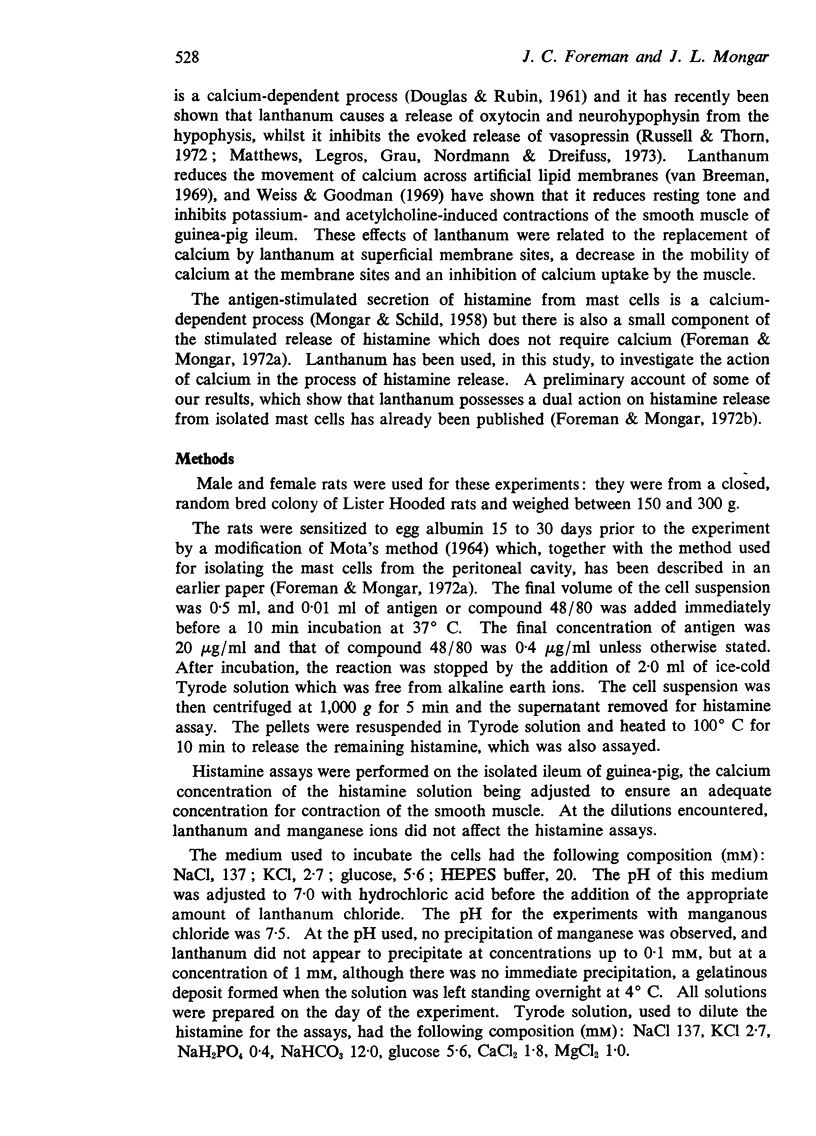
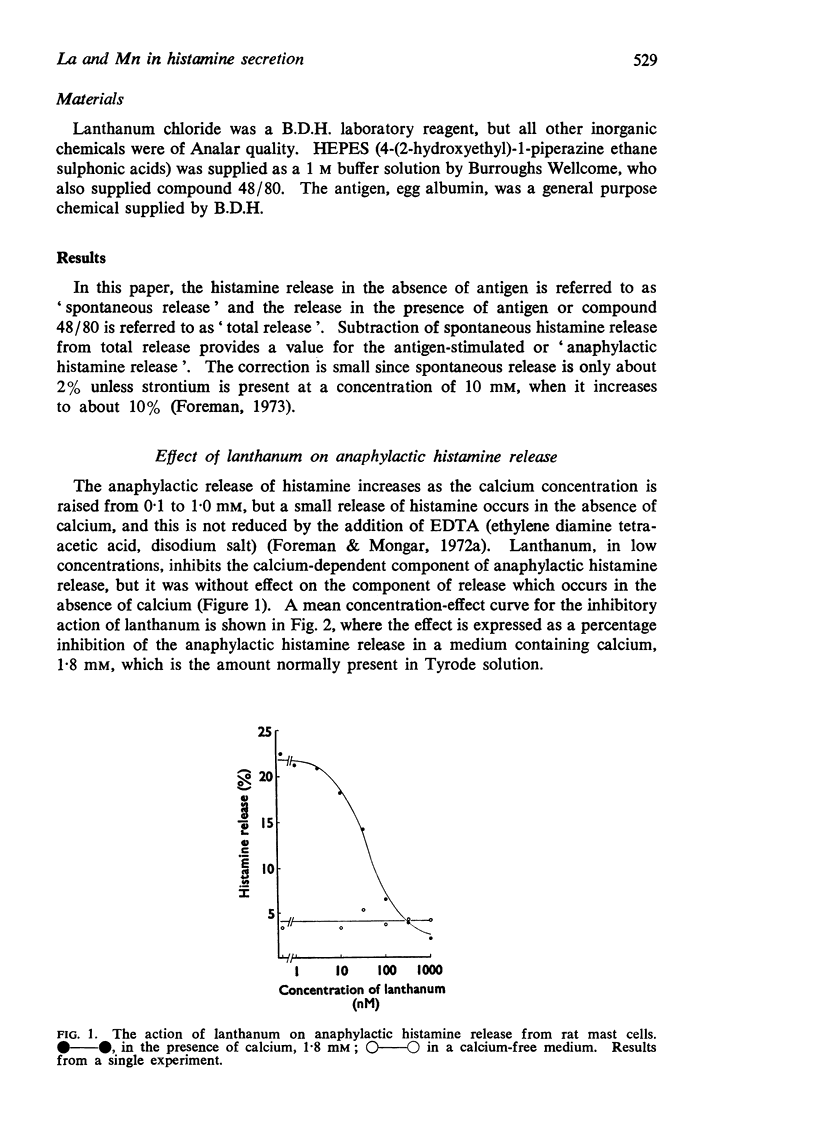




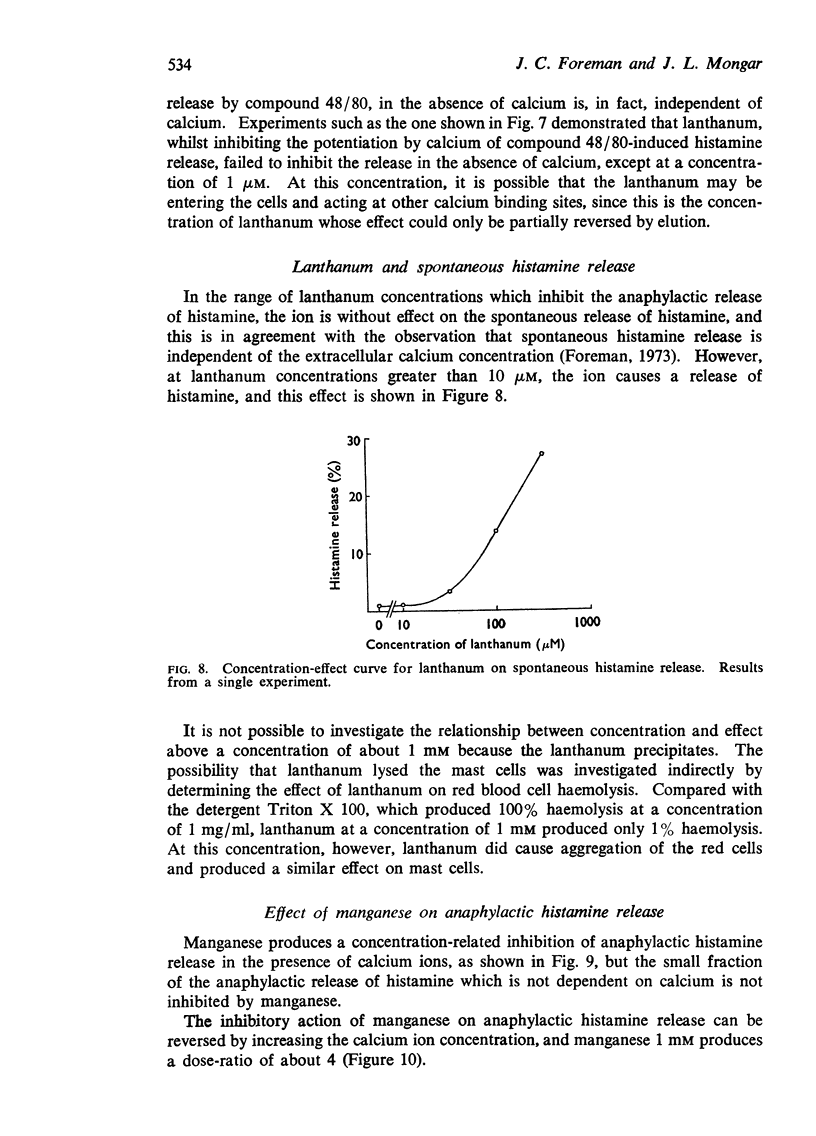
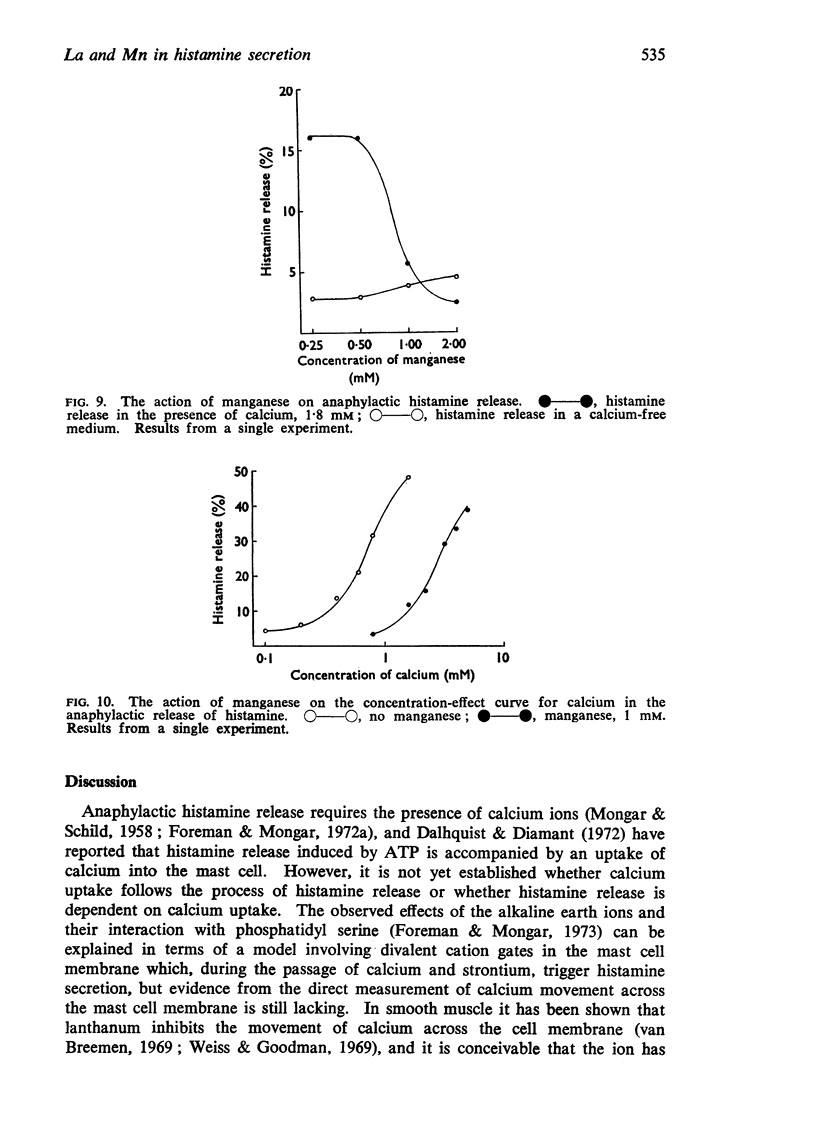

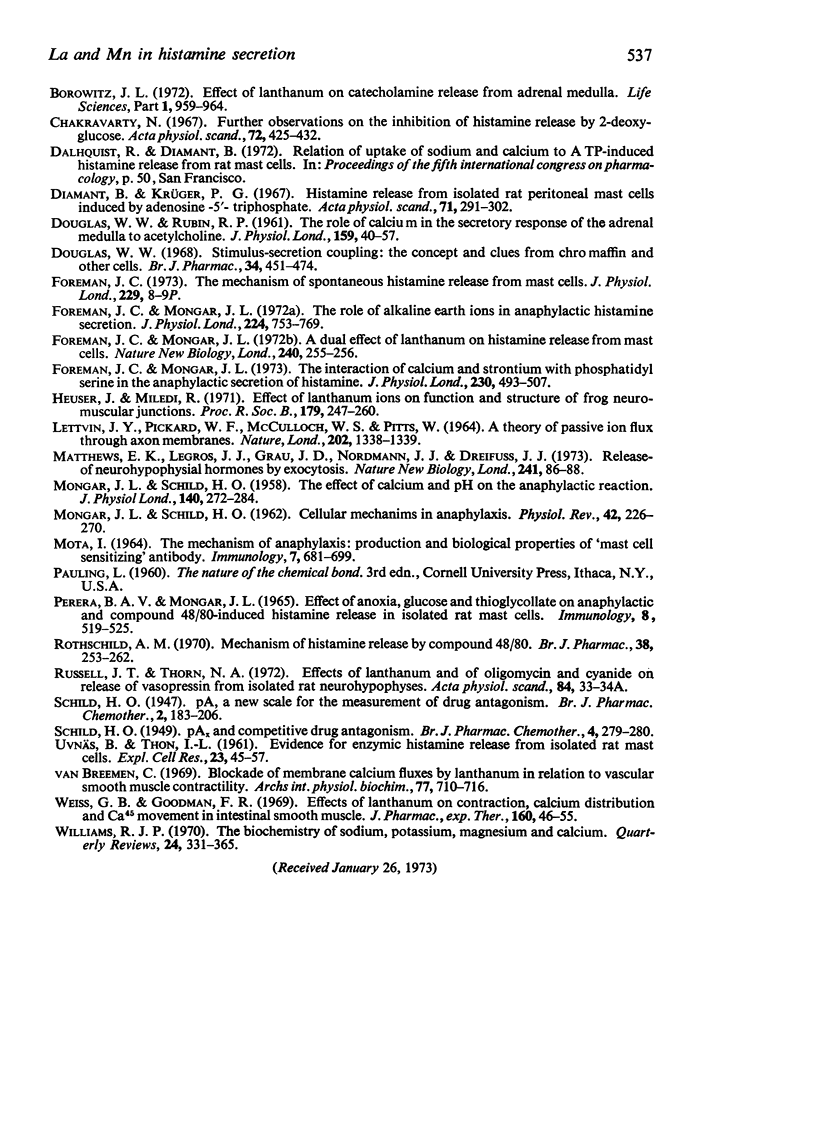
Selected References
These references are in PubMed. This may not be the complete list of references from this article.
- ARUNLAKSHANA O., SCHILD H. O. Some quantitative uses of drug antagonists. Br J Pharmacol Chemother. 1959 Mar;14(1):48–58. doi: 10.1111/j.1476-5381.1959.tb00928.x. [DOI] [PMC free article] [PubMed] [Google Scholar]
- Chakravarty N. Further observations on the inhibition of histamine release by 2-deoxyglucose. Acta Physiol Scand. 1968 Apr;72(4):425–432. doi: 10.1111/j.1748-1716.1968.tb03867.x. [DOI] [PubMed] [Google Scholar]
- DOUGLAS W. W., RUBIN R. P. The role of calcium in the secretory response of the adrenal medulla to acetylcholine. J Physiol. 1961 Nov;159:40–57. doi: 10.1113/jphysiol.1961.sp006791. [DOI] [PMC free article] [PubMed] [Google Scholar]
- Diamant B., Krüger P. G. Histamine release from isolated rat peritoneal mast cells induced by adenosine-5'-triphosphate. Acta Physiol Scand. 1967 Dec;71(4):291–302. doi: 10.1111/j.1748-1716.1967.tb03736.x. [DOI] [PubMed] [Google Scholar]
- Douglas W. W. Stimulus-secretion coupling: the concept and clues from chromaffin and other cells. Br J Pharmacol. 1968 Nov;34(3):451–474. doi: 10.1111/j.1476-5381.1968.tb08474.x. [DOI] [PMC free article] [PubMed] [Google Scholar]
- Foreman J. C., Mongar J. L. Dual effect of lanthanum on histamine release from mast cells. Nat New Biol. 1972 Dec 20;240(103):255–256. doi: 10.1038/newbio240255a0. [DOI] [PubMed] [Google Scholar]
- Foreman J. C., Mongar J. L. The interaction of calcium and strontium with phosphatidyl serine in the anaphylactic secretion of histamine. J Physiol. 1973 Apr;230(2):493–507. doi: 10.1113/jphysiol.1973.sp010200. [DOI] [PMC free article] [PubMed] [Google Scholar]
- Foreman J. C., Mongar J. L. The role of the alkaline earth ions in anaphylactic histamine secretion. J Physiol. 1972 Aug;224(3):753–769. doi: 10.1113/jphysiol.1972.sp009921. [DOI] [PMC free article] [PubMed] [Google Scholar]
- Foreman J. C. The mechanism of spontaneous histamine release from mast cells. J Physiol. 1973 Feb;229(1):8P–9P. [PubMed] [Google Scholar]
- Heuser J., Miledi R. Effects of lanthanum ions on function and structure of frog neuromuscular junctions. Proc R Soc Lond B Biol Sci. 1971 Dec 14;179(1056):247–260. doi: 10.1098/rspb.1971.0096. [DOI] [PubMed] [Google Scholar]
- LETTVIN J. Y., PICKARD W. F., MCCULLOCH W. S., PITTS W. A THEORY OF PASSIVE ION FLUX THROUGH AXON MEMBRANES. Nature. 1964 Jun 27;202:1338–1339. doi: 10.1038/2021338a0. [DOI] [PubMed] [Google Scholar]
- MONGAR J. L., SCHILD H. O. Cellular mechanisms in anaphylaxis. Physiol Rev. 1962 Apr;42:226–270. doi: 10.1152/physrev.1962.42.2.226. [DOI] [PubMed] [Google Scholar]
- MONGAR J. L., SCHILD H. O. The effect of calcium and pH on the anaphylactic reaction. J Physiol. 1958 Feb 17;140(2):272–284. doi: 10.1113/jphysiol.1958.sp005933. [DOI] [PMC free article] [PubMed] [Google Scholar]
- MOTA I. THE MECHANISM OF ANAPHYLAXIS. I. PRODUCTION AND BIOLOGICAL PROPERTIES OF 'MAST CELL SENSITIZING' ANTIBODY. Immunology. 1964 Nov;7:681–699. [PMC free article] [PubMed] [Google Scholar]
- Matthews E. K., Legros J. J., Grau J. D., Nordmann J. J., Dreifuss J. J. Release of neurohypophysial hormones by exocytosis. Nat New Biol. 1973 Jan 17;241(107):86–88. doi: 10.1038/newbio241086a0. [DOI] [PubMed] [Google Scholar]
- Perera B. A., Mongar J. L. Effect of anoxia, glucose and thioglycollate on anaphylactic and compound 48/80-induced histamine release in isolated rat mast cells. Immunology. 1965 May;8(5):519–525. [PMC free article] [PubMed] [Google Scholar]
- Rothschild A. M. Mechanisms of histamine release by compound 48-80. Br J Pharmacol. 1970 Jan;38(1):253–262. doi: 10.1111/j.1476-5381.1970.tb10354.x. [DOI] [PMC free article] [PubMed] [Google Scholar]
- UVNAS B., THON I. L. Evidence for enzymatic histamine release from isolated rat mast cells. Exp Cell Res. 1961 Feb;23:45–57. doi: 10.1016/0014-4827(61)90062-3. [DOI] [PubMed] [Google Scholar]
- Van Breemen C. Blockade of membrane calcium fluxes by lanthanum in relation to vascular smooth muscle contractility. Arch Int Physiol Biochim. 1969 Oct;77(4):710–716. doi: 10.3109/13813456909059783. [DOI] [PubMed] [Google Scholar]
- Weiss G. B., Goodman F. R. Effects of lanthanum on contraction, calcium distribution and Ca45 movements in intestinal smooth muscle. J Pharmacol Exp Ther. 1969 Sep;169(1):46–55. [PubMed] [Google Scholar]


